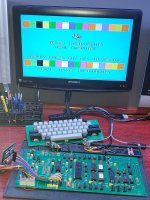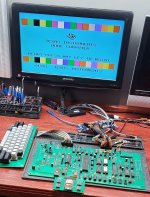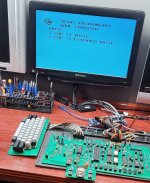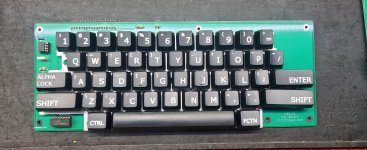danwerner21
Member
- Joined
- Feb 9, 2012
- Messages
- 29
I have been working on a clone board for the TI99/4a and have finally had a bit of success. I was able to obtain the "standard" TI chips (9900,9904, SN76489, 9918 & 9901) off e-bay fairly easily and I am emulating the GROM chips with an ESP32 microcontroller (the irony is not lost on me that the ESP could easily emulate the entire system . . . but it was cheap and available). Therefore, no actual TI99s were harmed in the making of this project  .
.
I still have a tiny bit of work to do, but it seems to work quite well.
It is pretty much a standard TI99/4a EXCEPT:
* Full 64K of 16bit wide ram on board (dip switches provided to enable/disable banks)
* On board socket for cartridge ROM
* Simplified Video RAM circuit to allow for static RAM
* modern Static RAM and EPROMs replacing the originals
* microcontroller emulating the GROM chips (sockets on board in case real GROMs are available)
* Cherry MX based mechanical keyboard
* Power supplied by standard ATX power supply
Left to do:
* Much more testing . . . (I don't even have the final PCBs here yet)
* write code for the microcontroller running the alpha lock switch toggle on the keyboard
* design 3d printed case
So . . . not exactly ready for building yet . . but here is the github repo with all of the work so far:

 github.com
github.com
Many thanks to Rob Krenicki who published his work with the TI/99 schematics that much of this is based on.

I still have a tiny bit of work to do, but it seems to work quite well.
It is pretty much a standard TI99/4a EXCEPT:
* Full 64K of 16bit wide ram on board (dip switches provided to enable/disable banks)
* On board socket for cartridge ROM
* Simplified Video RAM circuit to allow for static RAM
* modern Static RAM and EPROMs replacing the originals
* microcontroller emulating the GROM chips (sockets on board in case real GROMs are available)
* Cherry MX based mechanical keyboard
* Power supplied by standard ATX power supply
Left to do:
* Much more testing . . . (I don't even have the final PCBs here yet)
* write code for the microcontroller running the alpha lock switch toggle on the keyboard
* design 3d printed case
So . . . not exactly ready for building yet . . but here is the github repo with all of the work so far:
GitHub - danwerner21/TI99_22: a 2022 replica of the classic TI/994a, using obtainable parts
a 2022 replica of the classic TI/994a, using obtainable parts - GitHub - danwerner21/TI99_22: a 2022 replica of the classic TI/994a, using obtainable parts
Many thanks to Rob Krenicki who published his work with the TI/99 schematics that much of this is based on.





